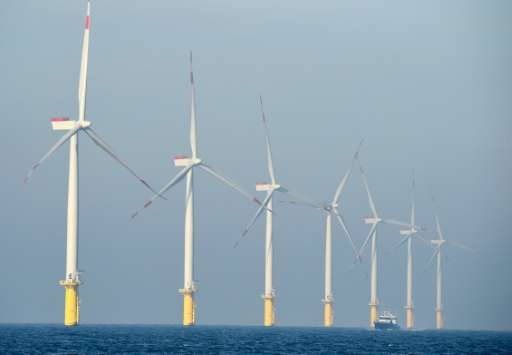Five questions on Germany's green energy shift

Germany's 'Energiewende' or energy transition is its biggest infrastructure project of the post-World War II era, and its greatest national challenge since reunification in 1990.
Over the past two decades, thousands of wind turbines and solar farms have mushroomed across the country, boosted by state subsidies.
Some hail the ambitious programme as a bright green vision for a zero-carbon future, others slam it as a reckless gamble that will drive Europe's biggest economy against the wall.
What is the energy transition?
Germany aims to switch from largely nuclear power and carbon-based energy toward clean renewables such as wind, solar, biomass and hydropower this century.
The idea is to slash Germany's carbon footprint, combat climate change and achieve energy independence, without hurting citizens' lifestyles or the export-based economy.
By mid-century Germany aims to meet 80 percent of its power needs with alternative energy, up from about one third now.
As an interim goal, half of its electricity supplies are meant to stem from green sources by 2030, a drive that also heavily relies on boosting energy efficiency and cutting consumption.
Why is Germany doing it?
Germany's traditionally strong environmental movement has long pushed for nature conservation and protested against nuclear power, especially since the 1986 Chernobyl disaster in Ukraine.
A left-green government started the energy transition and planned nuclear exit in the late 1990s.
Conservative Chancellor Angela Merkel initially reversed this but, after Japan's 2011 Fukushima disaster, bowed to popular pressure and decided to shutter all of Germany's atomic reactors by 2022.
How does the transition work?
The shift has been driven not by big energy companies but local people and communities who have been able to go green and make money in the process.
Citizen-producers and 'energy farmers' have been allowed to sell excess power back into the grid, at premium prices guaranteed over 20 years, making wind farms and solar fields profitable investments.
This month, Germany passed new laws meant to cap the subsidies, which have been passed on as surcharges to consumers, and to make the system more market-based.
From next year, renewable energy projects will be put out to tender, with the most competitive bids getting the handshake.
What are the problems?
Aside from rising power bills, the energy shift has hit other speed bumps, including technical hitches that have delayed some giant offshore windfarms.
On land, local protests have slowed to a crawl the building of high-voltage power lines between Germany's windy north and where the power is most needed, the industrial south.
Big power companies such as EON, RWE and Vattenfall have meanwhile taken a beating amid a glut of green electricity that has driven down wholesale prices.
Some are seeking to reinvent themselves as 'green' utilities and are suing the government for lost nuclear power profits, while haggling with the state about the huge bill to dismantle the plants.
Ironically, carbon emissions have also gone up in the short term.
This has happened because power companies have had to shutter, for example, some under-utilised and unprofitable modern gas plants and filled the gap with cheaper and dirtier coal, which generates over 40 percent of electricity needs.
One reason coal is cheap is that Europe's carbon emissions market—which is meant to price in the cost of pollution—has collapsed.
What happens next?
Merkel has hailed the pro-market reforms as a "paradigm shift" to make the energy transition economically viable.
Critics fear it will torpedo Germany's clean energy and climate goals.
All sides agree the Energiewende remains a work in progress, with more wobbles to be expected down the road.
In the longer run, Germany will have to boost storage capacity for fickle renewable energy, to ensure stable supplies on days when the sun doesn't shine and the wind doesn't blow.
Proposed solutions include smart grids that fluidly balance supply and demand, and steps such as using electric car batteries as integrated home power storage devices.
So far electric cars make up less than one percent of vehicles on German roads, but the government and big car makers are trying to boost sales with a new subsidy programme.
Environmental pressure groups, meanwhile, have set their sights on Germany's coal plants, setting the stage for political battles over an industrial sector that employs tens of thousands of people.
© 2016 AFP





















